"Reimagining Faith, Hope, and Love"
A visit to an exhibit of work by painter Deborah Joan Lanino, excerpts from my interview with her, and an evaluation of her work by Bay Area artist, Justyn Zolli
On Monday, December 9, my friend Roxane Galaher and I drove north an hour from San José to the Blackfriars Gallery at the Dominican School of Philosophy and Theology in the picturesque Berkeley hills. The day was perfect, clear and crisp, and chilly, and when we got to Berkeley we remarked about the unique quality of the light. It had a bright clarity we don’t see back in smoggier San José. We were on our way to attend an art exhibit titled, “Reimagining Faith, Hope, and Love.”
The artist, Deborah Joan Lanino, had notified Maggie Gallagher, Executive Director of the Benedict XVI Institute of Sacred Music and Divine Liturgy about her exhibit, and Maggie asked if I was interested in writing about it. One incentive was the promise that the B16 Institute would treat me and my friend to the cost of a good lunch. Another incentive was having the chance to get to check out the DSPT gallery and Deborah Lanino’s art, at least some of which is specifically Christian in its themes.
"REIMAGINING FAITH, HOPE, AND LOVE"
An exhibit of art by Deborah Joan Lanino
At Blackfriars Gallery
2301 Vine Street, Berkeley, CA 94708
September 22 through December 12, 2024
The Blackfriars Gallery is located in one of the school’s buildings that are grouped around a peaceful, landscaped garden. When I saw in one of the pots there that some succulents that I’ve seen growing flat on the dirt in other pots were growing at the tops of three-foot-high stalks, I remembered that the San Francisco Bay Area has many climate zones, and in Berkeley’s microclimate, some plants flourish in surprising ways you don’t see in other places. Berkeley is on the east side of San Francisco Bay, directly opposite the Golden Gate, which is the entrance from the Pacific Ocean to the bay. The eastward fog flowing from the ocean often blankets Berkeley, bringing in a lot of moisture. Here’s one example of the effects of the fog: In the Berkeley neighborhood where my husband’s brother lived, where we stayed for a few months in the late 1960s, I had been surprised to see a poinsettia of the kind you usually see in a 6” pot at Christmas had been planted in the side yard and was taller than the house next door. Newly arrived on my first trip ever away from Massachusetts, I got to taste my first fig ever—not from a supermarket—but fresh from a tree in the family’s backyard, which was bearing fruit next to a 20-foot-tall coastal redwood the family had planted only a few years earlier when they first rented the house. Coastal redwoods usually grow in the forests in circles in family groups that support each other with their shallow roots connected underground, and they rely on coastal fogs for moisture, which they take in through their leaves—but this one orphan redwood was thriving even without family support, getting the moisture it needed from the Berkeley fog.
On our way into the garden, I called out to a white-robed young man with a grey knit cap and a large wooden rosary hanging from a belt around his waist, who was walking away from us, to ask him where to find the gallery. He told us he is a Dominican brother, studying to be a priest. I also asked him why the gallery and the Dominicans are named Blackfriars when their habits are white. He told us that the Dominicans became known as ‘Black Friars,’ because of the black cape (cappa) the brothers wear over their white habits for warmth and when traveling.
We followed the direction he indicated through a doorway that opened into a large well-lit room. Two classrooms with large glass windows make up part of one of the walls.
When I looked through a window into one of the classrooms, I was surprised to see artist Justyn Zolli sitting in one of the classes that were going on. Justyn in his more artsy-type attire stood out from the other students, most of them young men in white habits. Later when we connected on Facebook, he told me he is working on an M.A. in Theology there. He also said he has had two exhibits at that gallery of his own work and co-curated an exhibit of historic Catholic art there last semester. Zolli’s work is mostly abstract, and he also does more figurative art for church commissions.
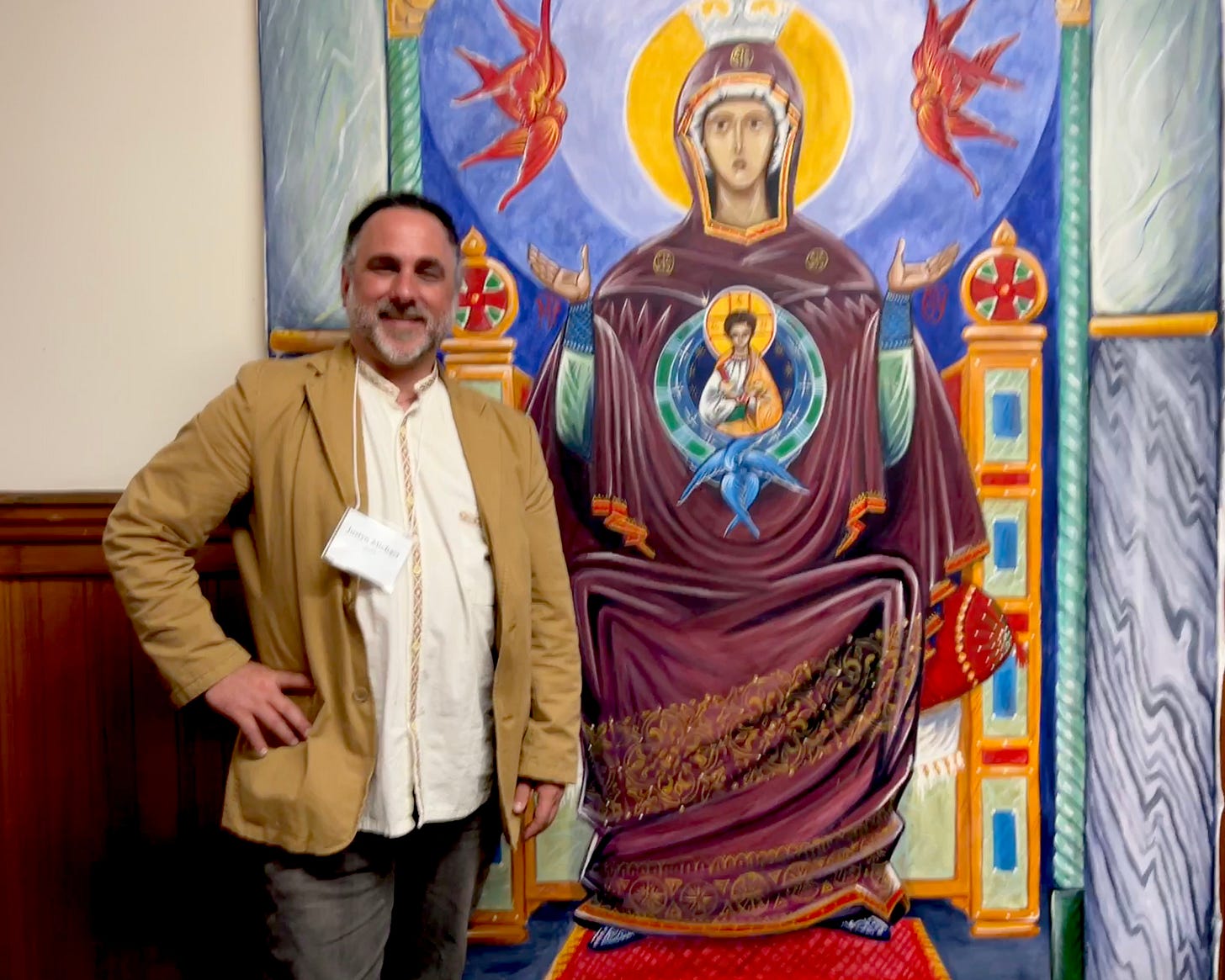
I mention Justyn, who I met at the large Artists Retreat put on by the Benedict XVI Institute last summer, and who I run into frequently at B16 events, because I asked for his reaction to Deborah Lanino’s works. He met her at her show’s opening, and he told her in a Facebook comment that it was a great show. I have included his detailed response further down in this article, after some questions and answers from an interview I did with her.
Brief Notes About the Exhibit
The exhibit focused primarily on work Lanino created over the past four years. She began these paintings in 2020 while meditating about faith, hope, and love during the pandemic sweeping the world at that time.
The enforced time at home during the COVID shutdown teaching students over Zoom and not having to commute gave Lanino time to revisit her sketchbooks from your junior year in Italy during a year abroad while she was a student at Pratt Institute. While she was studying in Florence, Lanino chanced to see a poster advertising an exhibit of a Renaissance master painter, Bernardino Lanino. Encouraged by a teacher who suggested she could be related to the famous Tuscan painter, she took a train to Vercelli to see the exhibit. Since then, she has been tracing her genealogy and has unearthed leads that strongly suggest she is one of his descendants.
In some of her work during COVID, Lanino reimagined some of her namesake’s major works. For example, in Bernardino Lanino's “Three Musician Angels Beneath a Canopy” (1540), three naturalistic flesh-coloured angels play musical instruments in front of a dark background with a muted green and red canopy.
Deborah Lanino’s reimagined rendition, “Three Musician Angels – Glory to God” (2021) is painted impressionistically in bright pastel colors against a blue background. The figures are more sketchy, and other elements of the Bernadino Lanino painting are suggested by lines.
Q & A from My Interview with Lanino
The following quotes are from a Zoom interview I had with Deborah Lanino the day she took the show down, before she returned to her home in Los Angeles.
DJL: I was born in New York City, in Manhattan. I grew up, for the most part, in a town called Babylon. Long Island. That's where I lived as a child, near the ocean, which I loved. And then, I went to Brooklyn, New York for college. I went to Pratt Institute, and then I lived abroad in Italy. I lived in Florence for a while, which I also loved. I did my junior year abroad, and then I traveled a little bit afterward. That had a big influence on my art and my life. And then, after graduating, I moved to Manhattan, where I lived and worked as an illustrator for many years. My first book was “The Littlest Angel,” the Christmas Classic. So that was my first big commissioned illustration job.
RTS: The illustration you had in the show from that book was my friend, Roxane’s, favorite. She wants to buy it for her grandchildren. She’s got thirty-one grandkids. So you might have a big uptick in sales.
DJL: Well, the thing is, that book, that was a long time ago, in the nineties. So good luck trying to find a copy. They're still out there, but they're hard to find since it's a classic.
NOTE from RTS: Even though it’s out of print, I found few copies, all under $15, for example, here, and here.
DJL: They redo it every 10 years or so with a different illustrator. Same story. So mine was the nineties version.
When I lived in Manhattan, I was in Chelsea and Soho, so I didn't see too much greenery in my day-to-day life or too many plants or flowers or trees. So my work had more of a grayish blue dominant, a Payne’s gray, which is a mixture of ultramarine blue and black. Once I moved to California, we first moved to Santa Monica, which was really beautiful by the ocean, and my colors just naturally lightened up with the proximity to the ocean. Just walking around the city I’d see a lot of lovely trees and plants everywhere.
So as an artist, I picked up the energy of my environments and where I lived and it just naturally flowed into my palette I live in LA now in the valley. While working as a painter in California my colors definitely became lighter—which you could see in the works at the show.
RTS: How did the show go? You got some good reviews out of it, I see.
DJL: The one review in the Catholic Herald UK is wonderful. They featured at least five or six of the paintings in the digital version. And Family Tree Magazine did an article as well.
RTS: One of the other things I was interested in was your response to my question about whether your artwork is impressionistic. You say that it is impressionistic and expressionistic. Can you talk about the evolution of your style or how you ended up doing this particular type of art?
DJL: I’ve come full circle. I mean, as a child, I was very fortunate. My parents always took my sister and me to Manhattan when we lived in Long Island. We would go to the Metropolitan Museum of Art. I remember loving all the art there. And I kind of gravitated toward the Impressionists as a young child.
I tried to copy them as a little 12-year-old, sort of teaching myself how to paint and draw because the school program could only get you so far. I had a big interest in art as a young child, so I would sort of do my pastel versions of the oil paintings that I'd see from reproductions after going to the museum. So, I was always very passionate about that. I guess I was attracted to the colors and the mood of the works. When I was in art school, my style was, I would say, more expressionistic, a little more raw.
I was in art school at a time when that was the style, and the teachers, the style they worked in was abstract expressionism. So not at all figurative, and I enjoyed what I learned there, but then I ended up, like I explained, after New York, I moved to California and my style went back to being influenced by what I saw around me, the ocean, the plants, the colors.
RTS: What style would you say that your painting The Mustard Tree is?
DJL: It’s a fusion of impressionism and expressionism. It's not a realistic rendering. I mean, you can tell that it's a tree, but it's also done from a symbolic standpoint based on Scripture, the Parable of the Mustard Tree, and it's also expressionistic. It's also about the emotions of the story and it's not a rendering, but you can tell it's a tree.
RTS: Did you start by looking at a real tree? I ask because I’m interested in realism in figurative art. I like to do art that is more like a portrait of the thing I’m drawing or painting than an impression.
When I saw your Mustard Tree painting, it reminded me of how Ginko Trees look like this time of year with carpets of gold at their roots. This past Sunday made me a Ginko tree enthusiast. Driving home from Mass last Sunday, we passed one Ginko tree after another, whose green fan-shaped leaves had turned to gold, and each had a carpet of gold spread around its roots and the sidewalk. I read today that an individual Ginko tree will let down its leaves all at once when the temperature reaches a certain point. While we were driving, one of the Ginkos we passed chose that moment to release its leaves in a beautiful golden shower all at once. It was a lovely sight to see!
So, your painting “The Mustard Tree” was an inspiration to me. Today I snapped a few photos of neighborhood Ginko trees with their golden carpets underneath, although I didn't catch any of them in the act of dropping their leaves in golden shower. Now I'm adding to my to-do list: "Do a realistic Ginko unleaving, with a Shower of Golden Fan Shaped Leaves—inspired by Lanino's mustard tree."
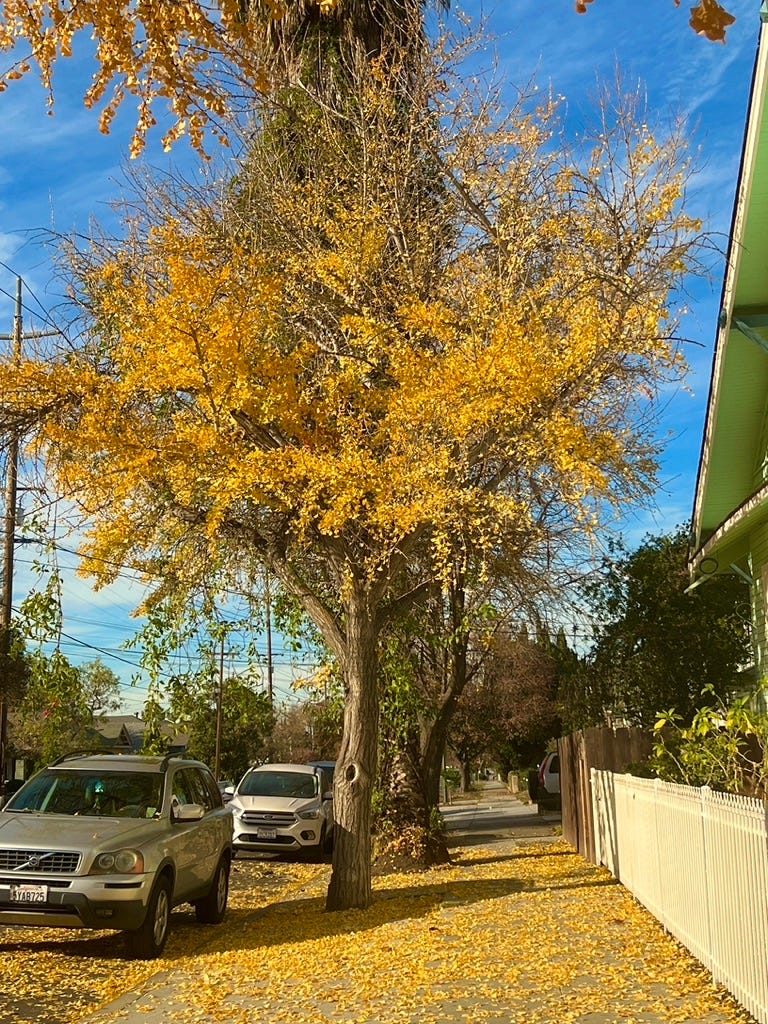
The black mustard tree, which is mostly like the kind of mustard tree (or bush) referred to by Jesus in His parable of the Mustard Seed, had the smallest seed then known. Unlike the flowering mustard that is considered beautiful when it grows in California vineyards and is considered a pernicious weed by Minnesota farmers I have known, black mustard can grow up to 10 to15 feet tall and grow equally as wide, so it is easily big enough for birds to nest in it.
DJL: Yeah, lots of endlessly beautiful, endless inspiration with the trees here in California. My son and I were taking Ginko leaves home, and we had a kind of a kit where you could do a photo impression of them. I was actually thinking a little of that Ginkgo tree when I did the mustard tree because it is a tree that blooms in yellow in my neighborhood where I live in Los Angeles. When I'm walking around with the dog in the neighborhood, I know exactly where all the Jacaranda trees and the ginkgo trees are. [Lanino has also done many paintings that are impressions of Jacaranda trees.] The Mustard Tree was sort of a tree that I made up because in the Scripture, sometimes they call it a mustard tree and sometimes they say it's a bush.
I was really focused on the contrast of that ultramarine blue in the background and the bright yellow, and there's even some gold in it depending on the lighting.
RTS: I read someplace that you said some things about how COVID affected you.
DJL: I was teaching at the time, and during the pandemic we had to teach in Zoom, and I found myself having a little extra time because I didn't have to commute, and I was sitting there and I was working out of a home studio at the time, so I found myself just rummaging through old sketchbooks from when I lived in Florence in the eighties, and I remembered, wow, I always wanted to do this project based on what I saw there when I lived in Italy about the Catholic arts and the sacred art and the connection that I felt with my ancestry and also the Bernardino Lanino exhibit. I had done some sketches. When I went to see the Lanino retrospective, I did some very loose, scribbly little sketches with colored pencils and dried-out magic markers of his compositions, and I said, one day I'd like to do a series on this, because it was very meaningful to me back then. I was a very impressionable 20 something year old.
Then life happened. I was a mom. I was teaching, and so I kind of just kept it there in my sketchbooks—I always told my students, always keep your sketchbooks. They're full of treasures and little sketches, little doodles that might turn into a painting or a series one day. So when I was looking through them, I just started doodling along. Sometimes I would draw along with the students when we were on Zoom and I realized that, “Yeah, I think now's the time to do that.” So I started painting the series and then it got interrupted. Sadly, my mom was very ill and I had to visit her, and my sister and I were going back and forth to Florida to take care of my mom. So that was sort of a pilgrimage in place for me. I couldn't go anywhere else except my studio and caring for my mom. So I was just in this little world of painting and thinking about family and life and what else there is after we live on this earth, and I just found myself in a different place altogether. The artwork was very healing for me, and I think for some of my students it was healing too, to be able to do some art. I noticed that for some of them it was good because that was a time that a lot of young people were struggling as well. Being locked in, shut in like that. So I wanted to do something with that time. I said, let me try to make something out of it. Usually I can never have the time to be in my home . . ..
RTS: What medium do you like to do work in best?
DJL: I really do love to work with gouache on paper with pastel. I love the feel of the gouache, how it's opaque, and I love working on paper. Some of the smaller pieces in the wall were gouache on paper with some charcoal and pastel. I love working on those smaller pieces, but for an exhibit, especially one that had such large walls and high ceilings, I felt I needed to do some larger scaled canvases. So for those, I work in acrylic. For example, “The Mustard Tree” is acrylic on canvas.
I used to work in oil paint originally, but what happened was I started working as a commercial illustrator for 10 years when I was doing the children's book, and I had to work with a medium that would dry quicker. And I also was working, when I lived in Manhattan, I was working in my apartment, so I didn't want to use the oil paints, even though I love the smell, I felt maybe I shouldn't work with that in a small apartment, because it can damage your lungs. So I switched over to acrylic paints. I love pastels. Sometimes I work with oil pastels and sometimes I work with chalk pastels.
Justyn Zolli on Deborah Lanino’s Work
For me, Deborah’s artwork reflects a soul that possesses a humble faith, a quiet love of art, and an appreciation of spiritual beauty. In her work, she blends Impressionist sensibilities while drawing from her own family history, like the artwork of her Renaissance artist-ancestor Bernardo Lanino, and those works of art history she connects with, like The Sower by Van Gogh. Nature, the sky, sacred trees, angels, Mary . . . this all comes together in an unostentatious and soft, feminine manner. Deborah worked as a children’s book illustrator for many years, and she also brings that direct clear method of communicating to her fine art works, which is refreshing. There is no pretense as in much religious art, or gimmick as in much more muscular contemporary art. She’s not going for big, brash, and bold. There is no sense that she is trying to proselytize to the viewer or be fashionable. She is just expressing the beautiful and colorful way she lives her life and inviting us as viewers to engage with it. There is a gentleness to the work that I greatly appreciate, especially in a world that shouts and demands our attention at every turn.
Which One Do You Like Best, and Why?
Let me know in the comments which version of “The Sower” you prefer from the five I’ve pasted below (inspired by Zolli’s mention of “The Sower’ by Van Gogh and Lanino’s reaction to it).
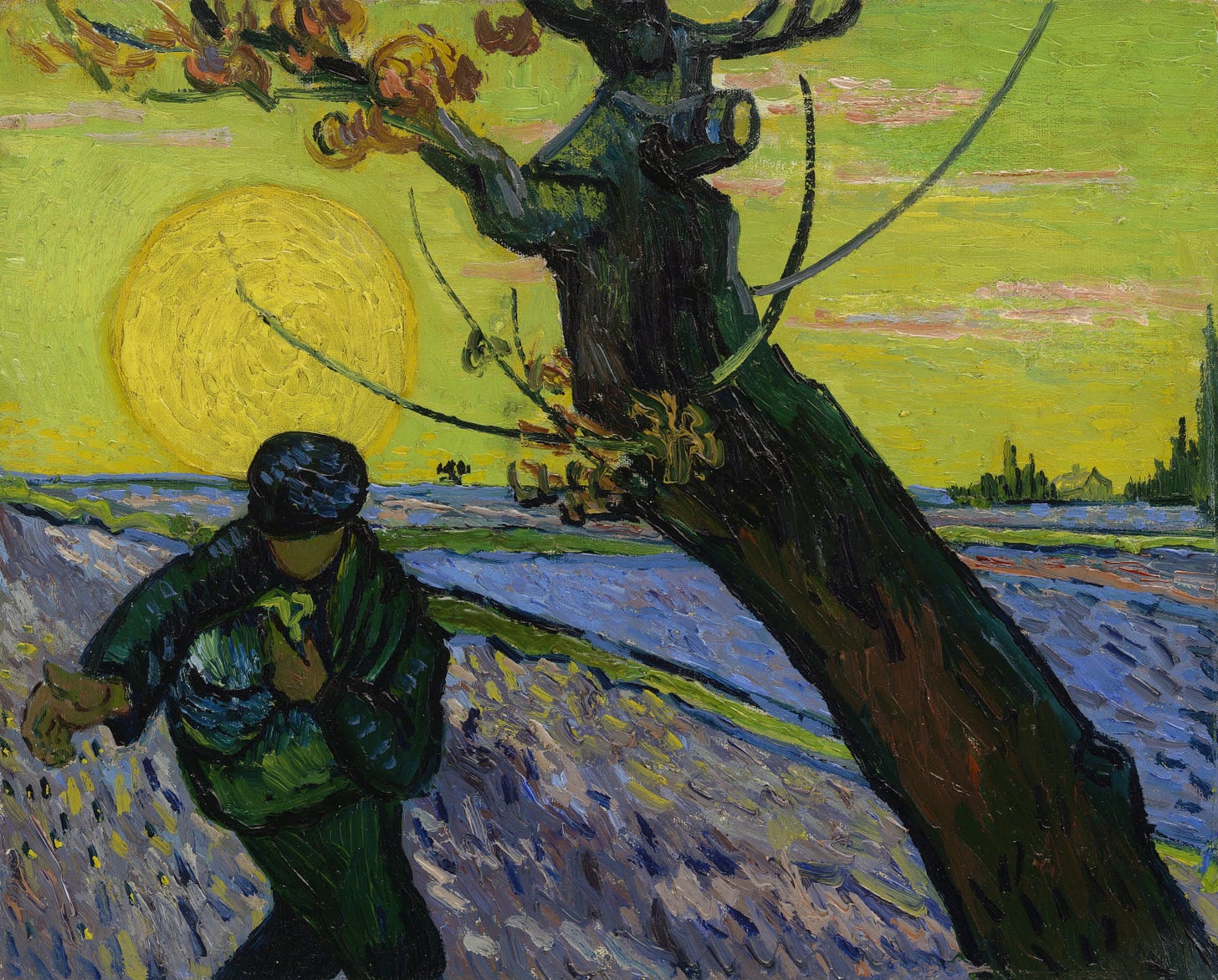
As I have written many times, in general, my preference is for the kind of realistic painting done by Norman Rockwell and James Tissot. Both of them have often been dismissed merely as illustrators, although, lately, many are starting to value them as brilliant creators of fine art. And so, in this case, I would pick the version by James Tissot, which is one of his illustrations for his book The Life of Our Saviour Jesus Christ. I admire the way Tissot used the medium of gouache in an untypical way, painting hundreds and maybe thousands of brush strokes on a sheet of watercolor paper about the size of a letter to create a work that is both a portrait of a real man and of a real place, from one of his several trips to observe the people and landscape of the Holy Land.
But I am also attracted to the ideas expressed by Hilary White, artist and writer, who posts at her Substack about “how physical objects of Christian sacred art – icons, buildings, works of art and music – are integrally related to the pursuit of mystical intimacy with Christ.” She argues that icons are more fitting theologically for portraying the events of sacred history, because they use a language that once it is learned brings the viewers in mystical contact with the people and events portrayed in the icon
Hilary writes about how Western art departed from the rules of sacred art when artists embraced naturalism and perspective and individual expression instead of using the traditional language of sacred art that had been developed over more than 1,000 years.
For those reasons, I would have to pick the icon “The Parable of the Sower,” by orΦίκος (Fikos), even though the other versions are more appealing to me and most moderns, who appreciate art that expresses the artist’s individuality, with gestures, and impressions over fully-realized art.
What do you think?
Contact Information for Deborah Lanino, Artist
Website: deborahlanino.com
Email: deborahlanino@gmail.com
Facebook: https://www.facebook.com/deborahlaninoartist
Instagram:
You Might also Like This Related Article
Tips are appreciated! Another option to help support my work: if you click the Subscribe button below, you can either subscribe for free (if you’re not already a subscriber), or switch to a paid subscription.



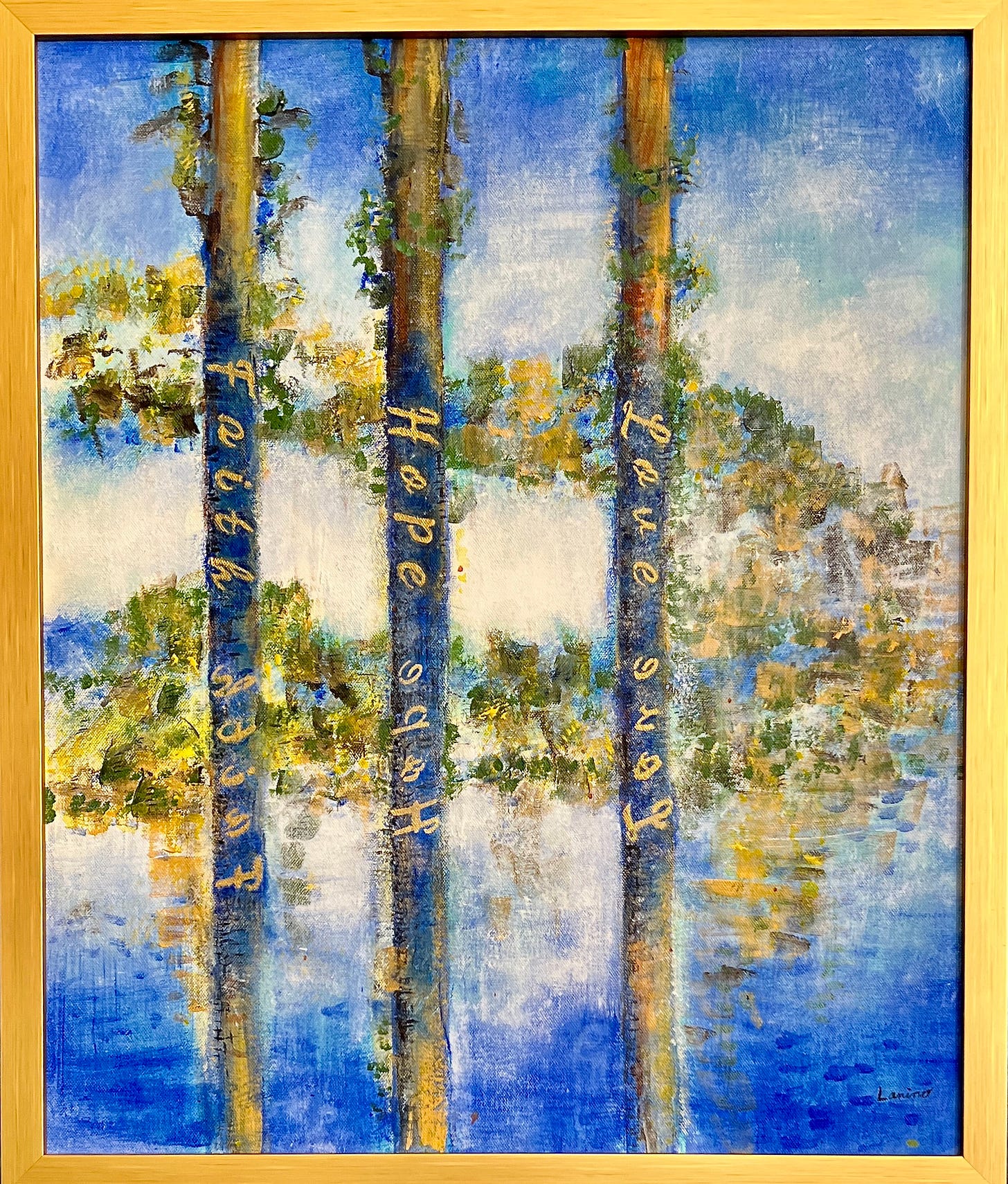
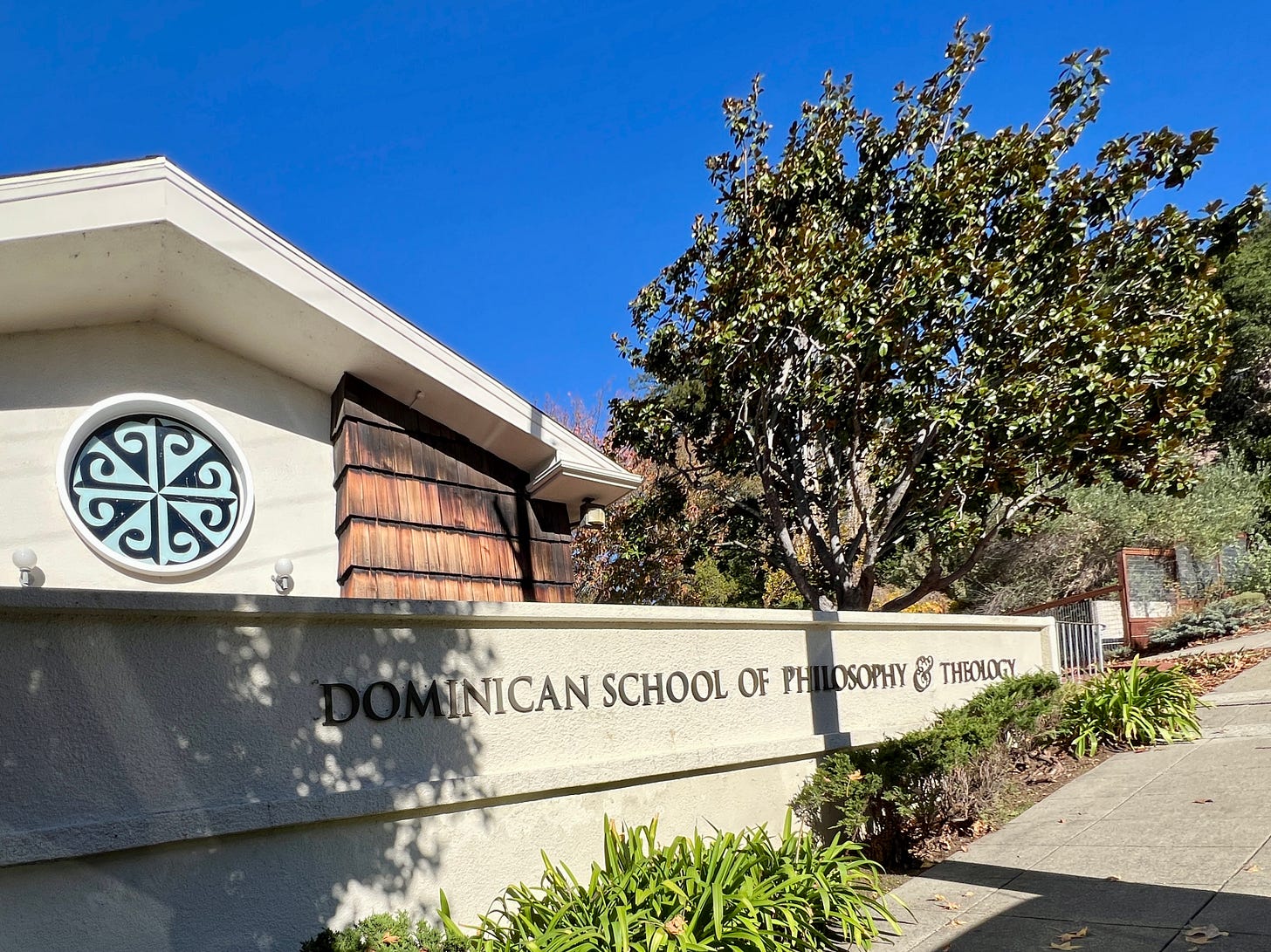
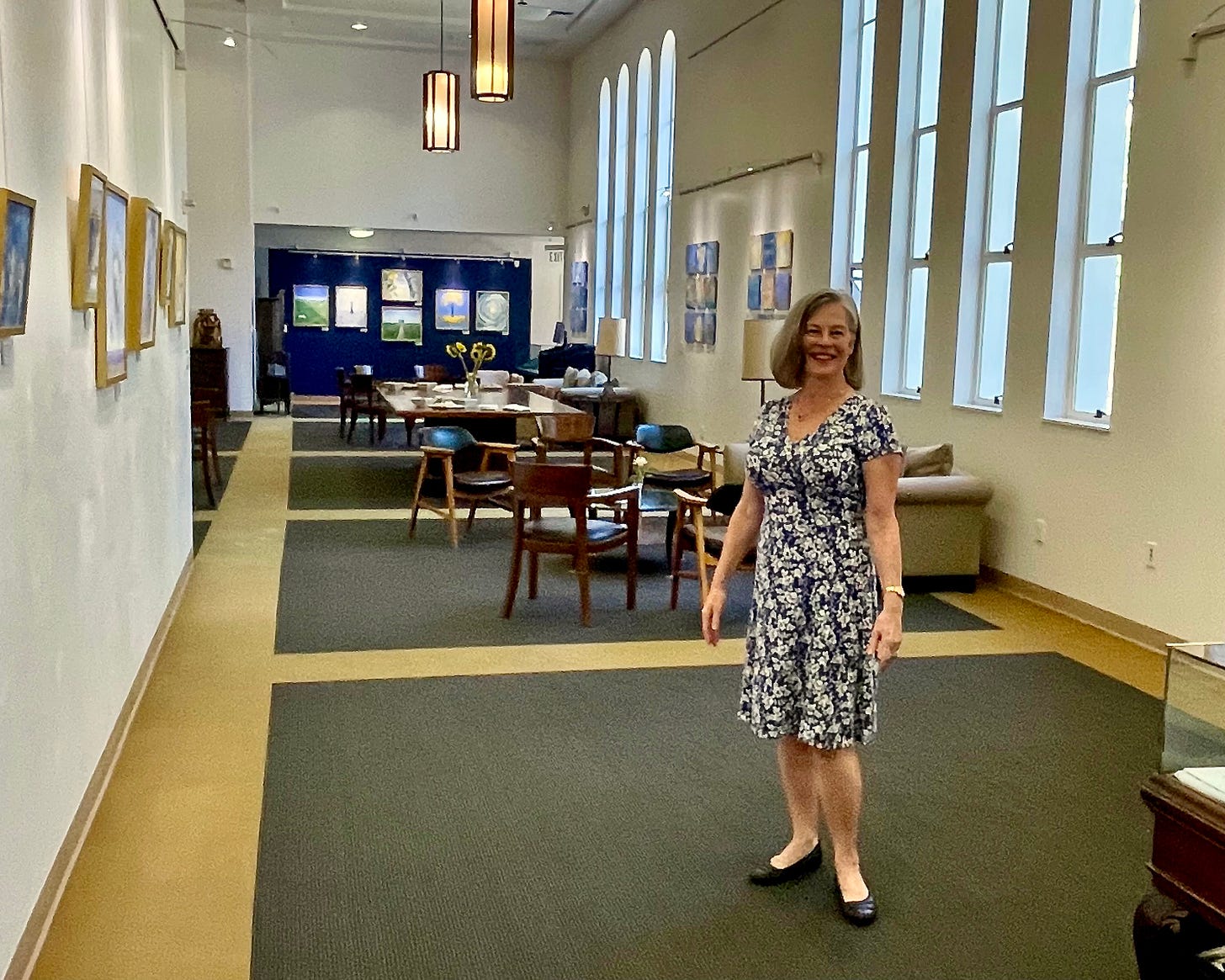
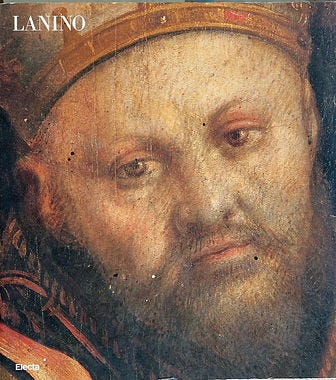

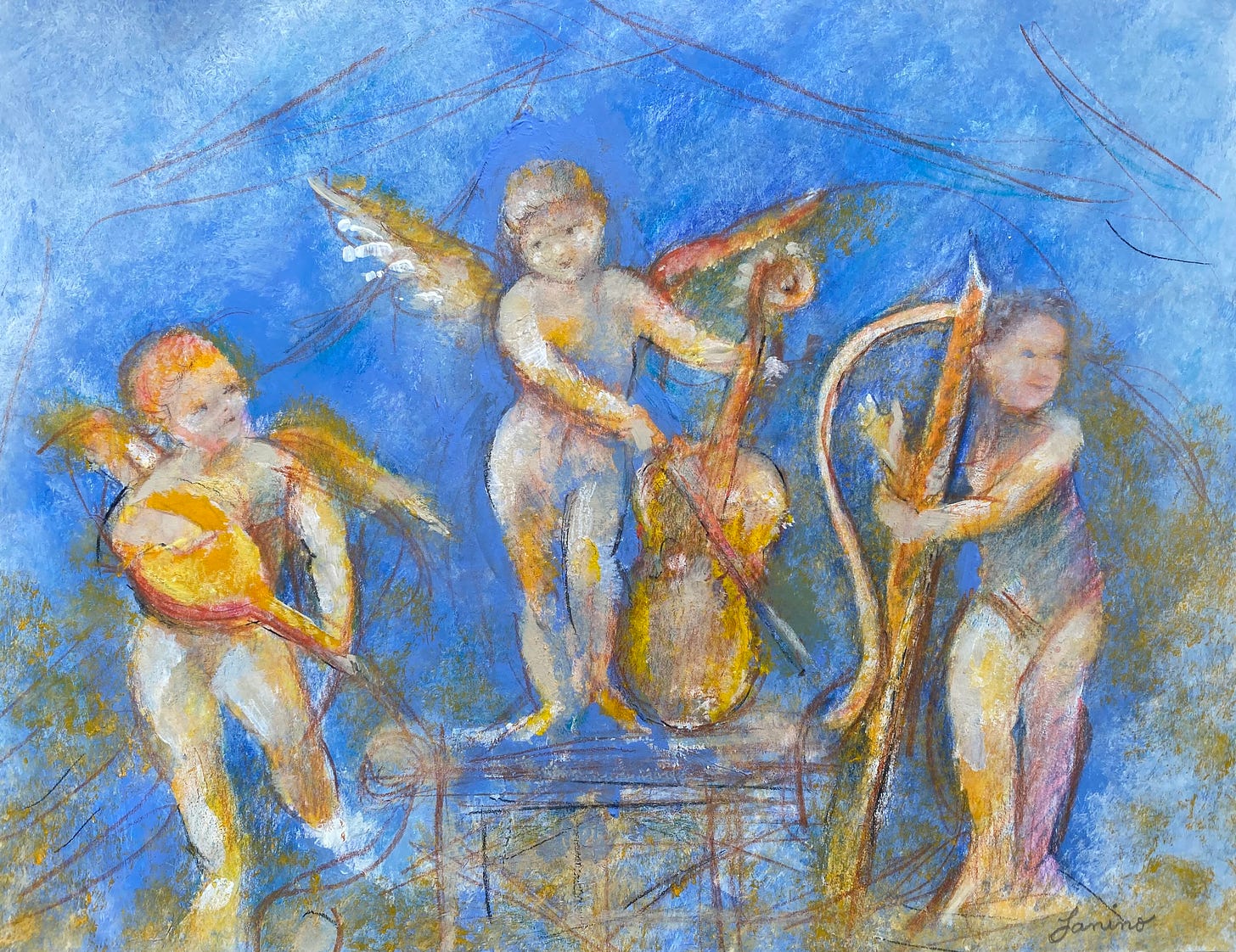
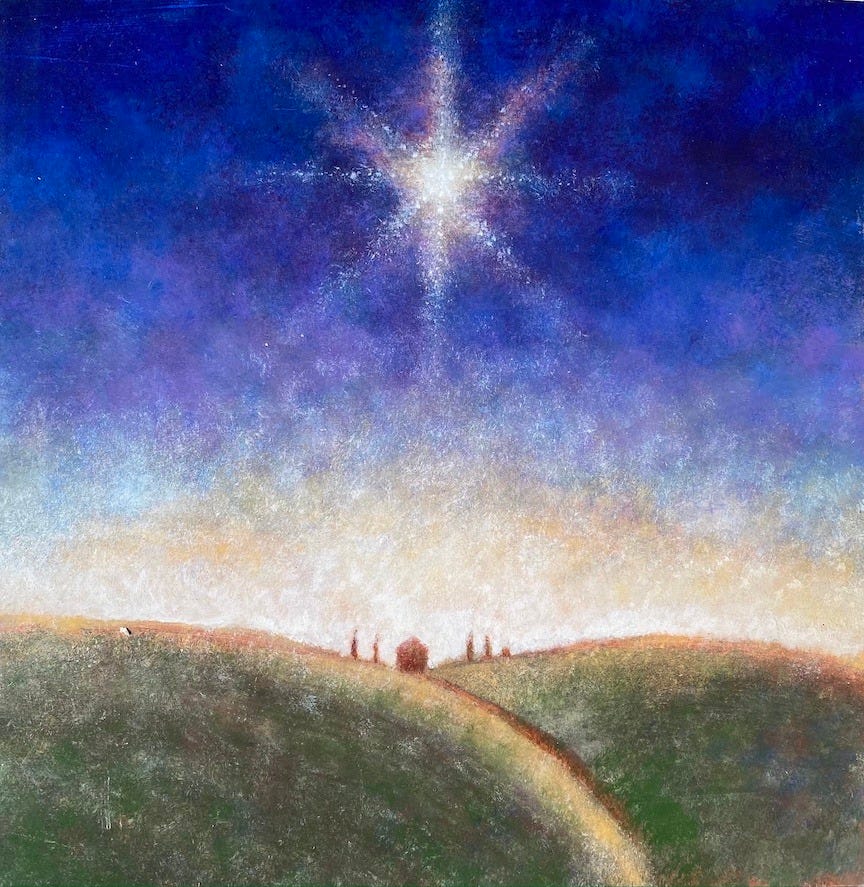
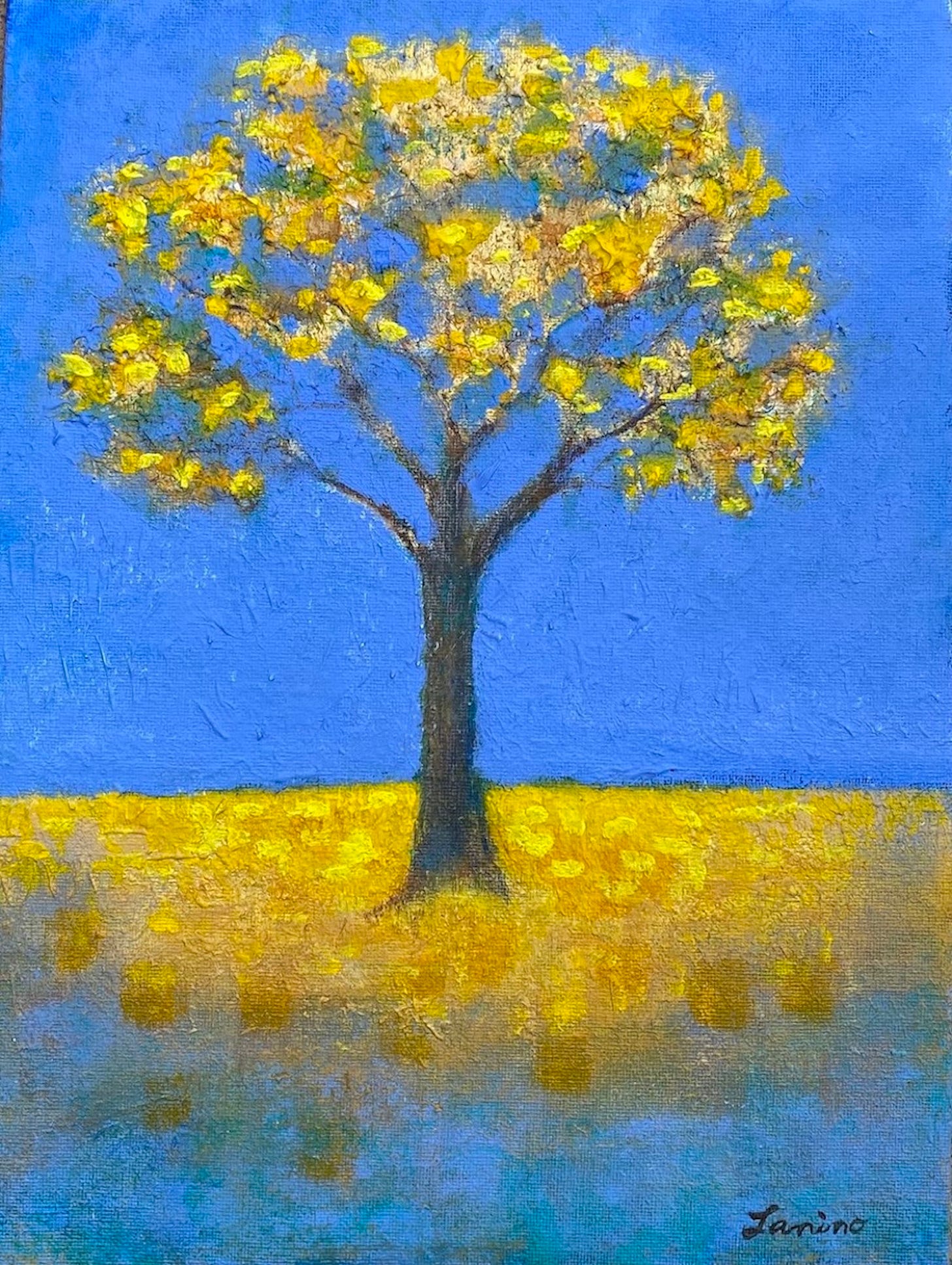
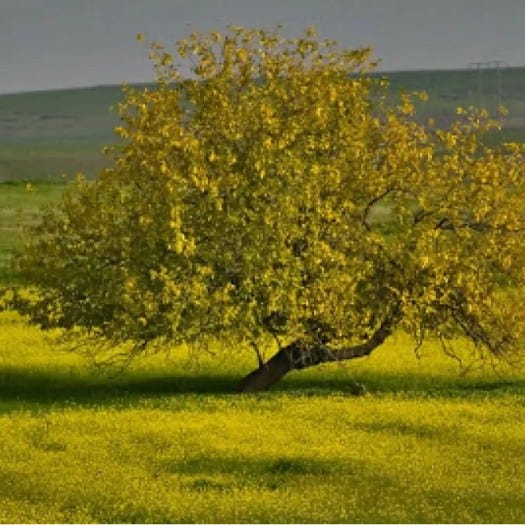
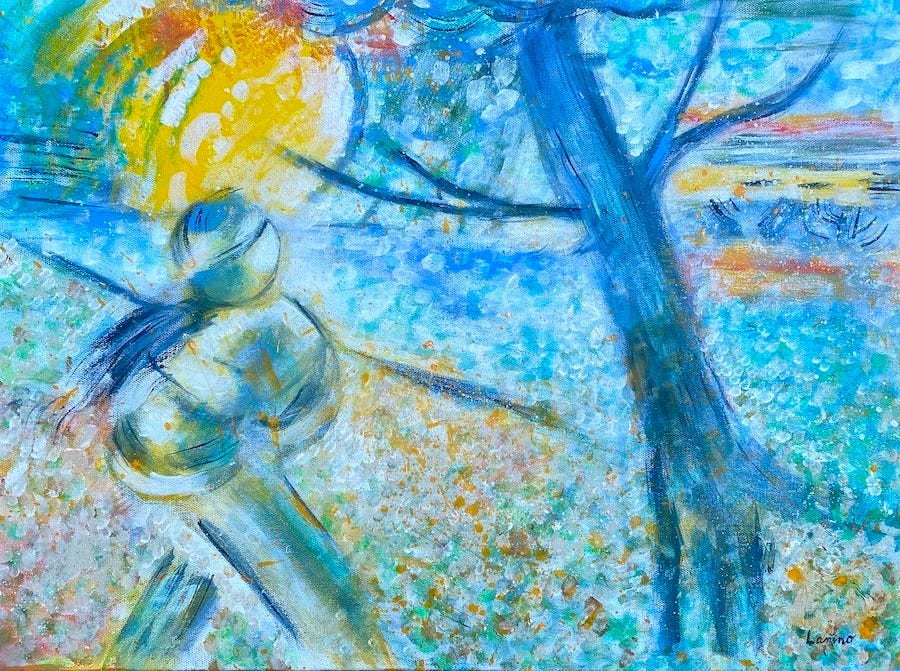
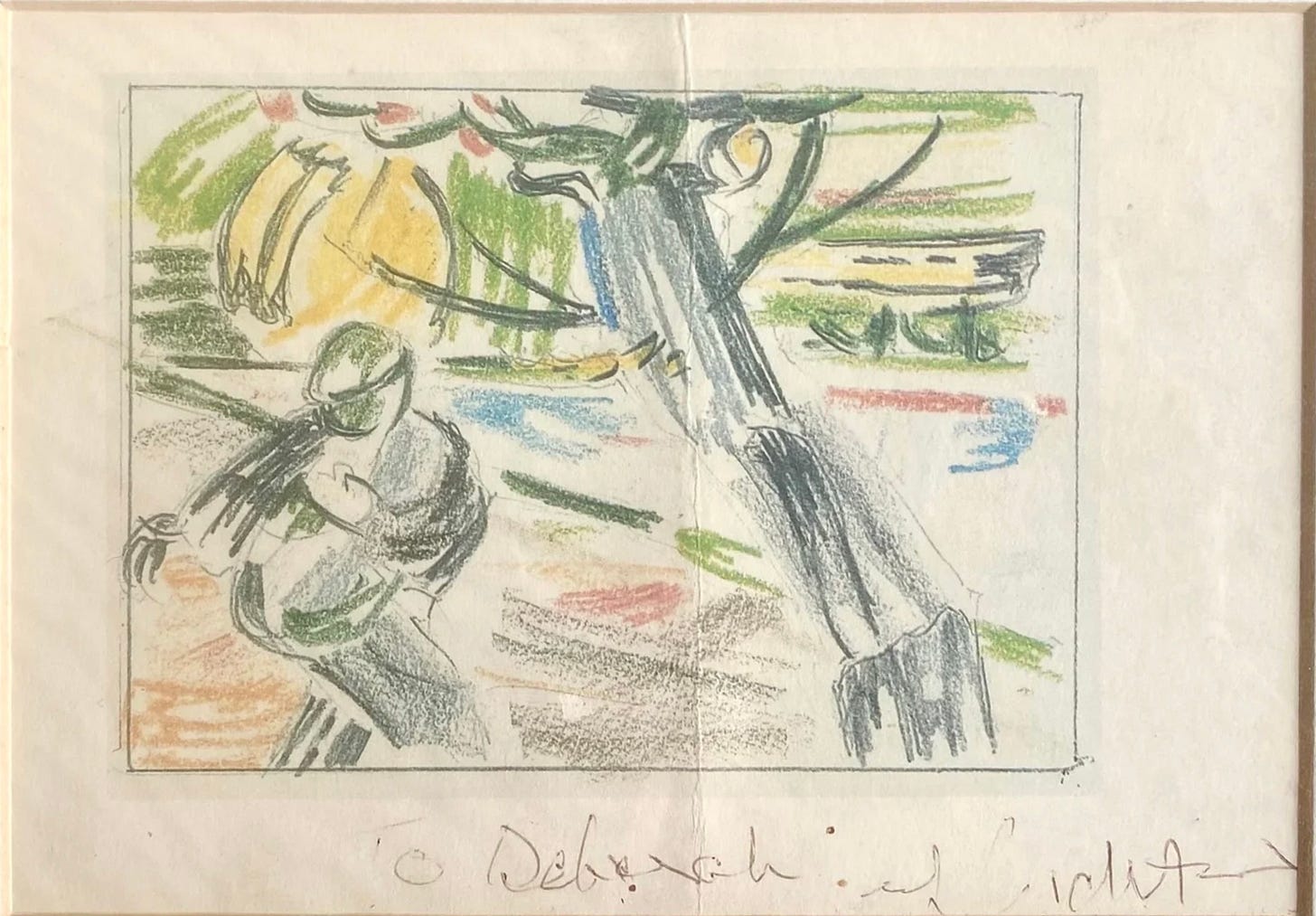
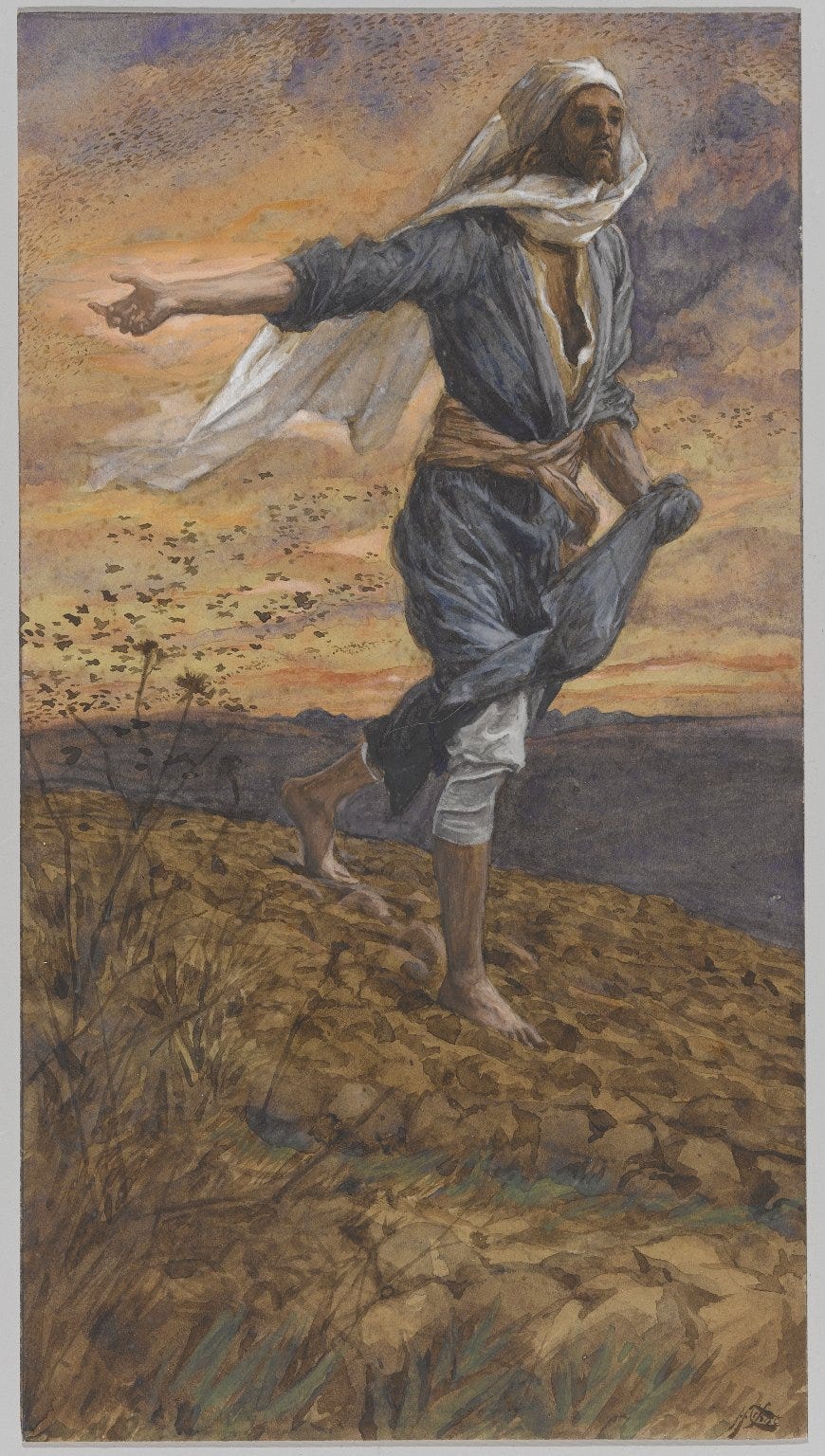
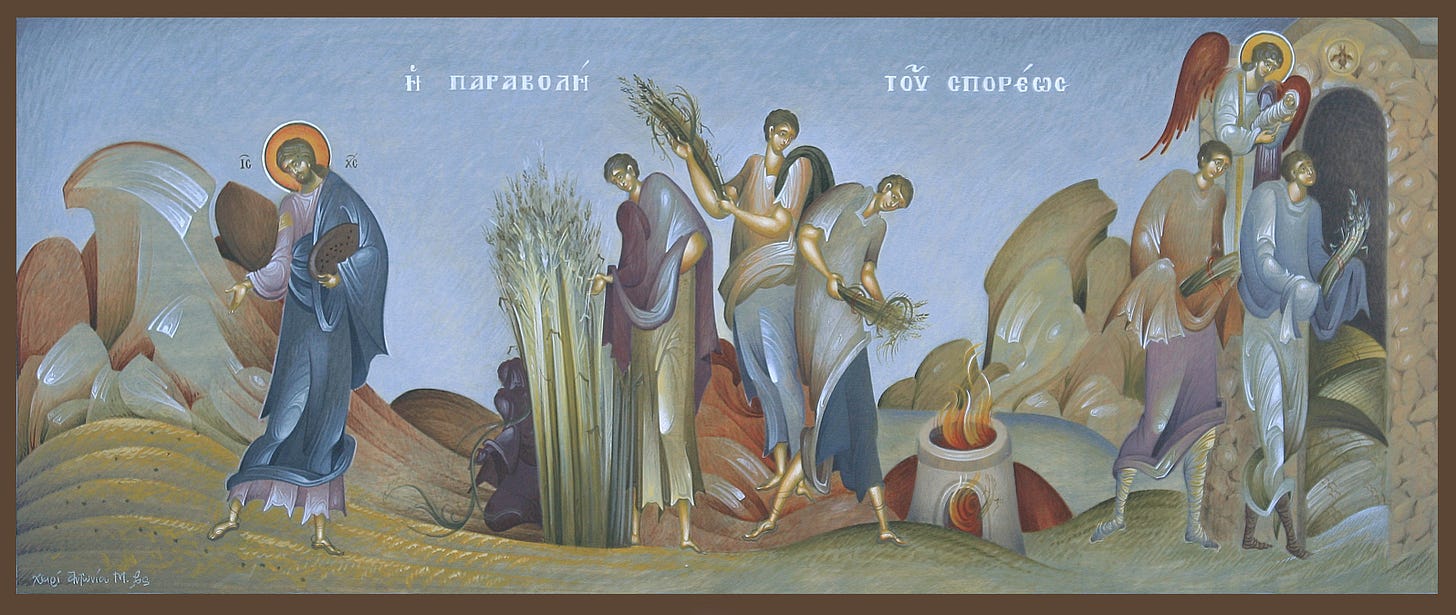
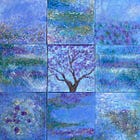
From Facebook: Wonderful article as always, Roseanne!
From email: Dear Roseanne,
Thank you Roseanne for writing this fine article. Also thanks for the interview with Justyn. Very nice! ... Please do tell your friend Roxanne that I still have many originals from the book as well as a few limited edition gicleé prints available for sale. PS I noticed more yellow trees on my walk yesterday and thought of you!
Warm Regards,
Deborah